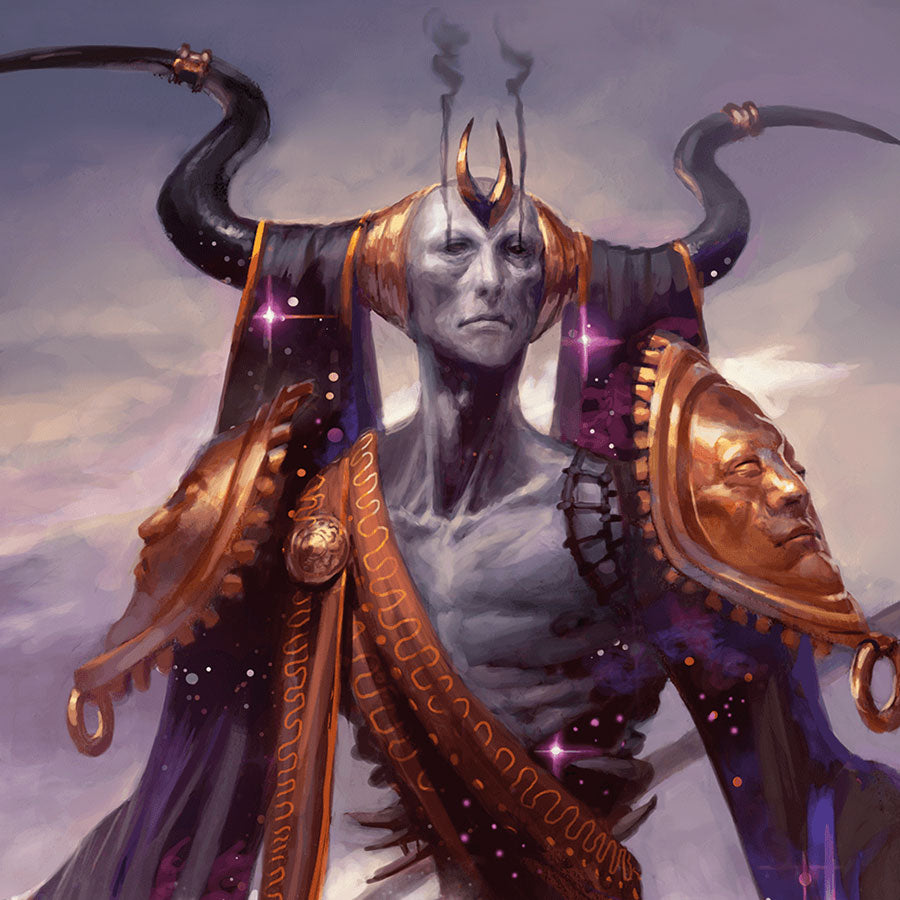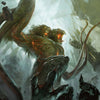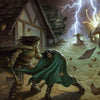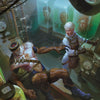4 Step Legendary D&D Boss Formula

Written by Luke Hart
So there they were. My players’ characters had just fought through a compound crawling with githyanki and yugoloths, and they were FINALLY facing off against the cold, calculated, cruel Githyanki leader. It was the final showdown. On the first round of combat, my player Ben’s paladin smited the githyanki leader for well over 50 points of damage. Then with his second attack, he smited again. And that was it; the githyanki leader was dead and fell before the victorious characters.
And then Ben said, “Really? That was it?” You see, I had failed my players. I had failed to give them an epic, memorable boss fight. After making their way through a dungeon filled with baddies, the final showdown was over in one short round.
In the aftermath, I was left to wonder: Should I have given the boss more hit points? Should there have been minions? What could I have done to make that a better boss fight?
Because, regardless of whether or not that combat was well-constructed from a rules standpoint – following the CR system, following the adventuring day mechanic – there was no avoiding one simple fact: my players were disappointed. The fight was anti-climactic. Again, I had let them down.
Now, I’ve made articles before about how to make epic boss fights in D&D that go over many important considerations, but what I haven’t done is break down how to convert an ordinary monster into a LEGENDARY monster – you know, giving it legendary actions, lair actions, unique abilities, that sort of thing. For instance, let’s say you want to take a standard Flying Sword and turn it into a Legendary Flying Sword called Rime’s Embrace, the Sword of Winter. How exactly would you do that?
So, today we are going to deep dive into how to do this, including how to adjust a creature’s challenge rating when you make it legendary, and it’s going to get pretty technical. So, for the sake of convenience, we’ve also included this guide for creating legendary creatures in the January 2023 issue of Lair Magazine, Prophecy & Power.
Watch or listen to this article by clicking the video below.
#1 Consider What Makes a Monster Legendary
Legendary Creatures are beings of extraordinary power whose legend is supported by both mechanics and lore; whether by the very nature of their existence, as is the case with ancient red dragons, or by being supreme among all others of its kind, such as a lich among undead, they are granted the status of legendary both out of fear and respect for their might.
However, it doesn't have to be a creature type such as those previous examples. A legendary creature can be any being with the mechanical and reputational requirements to be considered a "creature of legend." These creatures should rarely a surprise when they appear as characters will have heard rumors of their presence or perhaps be questing for the specific purpose of hunting such a creature down and bringing its reign of terror to an end.
But what makes a Legendary Creature... legendary? From a mechanical standpoint, a Legendary Creature is any creature with any combination of "legendary abilities," which include Legendary Resistance, Legendary Actions, and sometimes Lair Actions. A Legendary Creature that is a variation of a standard creature type, such as a legendary hobgoblin chieftain, probably has the edge over others of its kind even without the legendary abilities.
However, from a narrative perspective, such a creature should have a story, or "legend," that has grown around them, making them stand out among their own kind and encourage fear or awe in common folk. People that live near an ancient red dragon probably know that the creature lurks nearby and fear the day it wreaks havoc on them. Those living near a lich probably tell stories of the terrifying creature, even if they don't truly understand what it is. These stories could be true, but more often than not, such a creature's legend grows beyond the truth.
Thus, your task as the game master is to NOT ONLY create the mechanical aspects of a legendary boss monster BUT ALSO to weave the story or legend that has developed around the creature. And then, of course, impart it to your players over the course of the game leading up to their presumed showdown with the legendary creature.
To help us better understand how a normal creature can become legendary, let’s follow the example I mentioned earlier: Rime’s Embrace, the legendary flying “Sword of Winter”. Now, a normal flying sword has the stat block on page 20 of the D&D 5e Monster Manuel.
Looking at the stat block, there are several ways to make Rime’s Embrace stand out among flying swords. First, perhaps Rime’s Embrace was a frost brand before it was animated rather than a normal sword. This would mean it deals an additional 1d6 cold damage on a hit, has resistance to fire damage, sheds bright light in a 10-foot radius and dim light for another 10 feet in freezing temperatures, and extinguishes all nonmagical flames within 30 feet of it.
To build on the creature's legend, let’s make it sentient, with a higher Intelligence, Wisdom, and Charisma, give it an alignment and the ability to speak Common, and give it the narrative ability — no mechanics required — to command other flying swords and animated armor in battle. Finally, a magical sword should have more hit points than a normal sword, so increase its hit dice from 5 to 12 for a final hit point total of 42. You see, with just these few changes, Rime’s Embrace is already beginning to shape itself into a creature of legend.
And now it’s time for a note on CHALLENGE RATING which can be the most difficult part of creating a legendary boss monster.
Any time a game master changes anything in a creature's stat block, it can affect its Challenge Rating. Making a creature legendary is guaranteed to do so in almost all cases. Now, there is no substitute for recalculating a creature's Challenge Rating using the rules in the Dungeon Master Guide.
However, not everyone wants to do that much math. So, as we move along here today, I’m going to provide "Challenge Rating Considerations" that provide a high-level, "best guess" method of adjusting the creature's final Challenge Rating to ensure that it remains reasonable for the characters DOOMED to face it in battle.
Another important point: changes to Challenge Rating become less dramatic as the characters increase in level. During tier one play (levels 1 to 5), even minor changes to a stat block can significantly increase its Challenge Rating. In tier two (levels 6 to 10), this becomes less dramatic but still a significant consideration. However, adjusting the CR becomes less of an issue as the characters advance through tiers three (levels 11 to 16) and four (levels 17 to 20).
For the example of Rime’s Embrace, adjustments are being made to a CR 1/4 creature that will probably face tier one characters. So, Challenge Rating must be carefully monitored.
Now, while the idea of putting out torches, shedding light, and being smarter may not seem too unbalancing, the extra 3 points of damage (on average), added fire resistance, and increased hit points will have an impact, raising the challenge rating of Rime’s Embrace.
A quick glance at the tables in the Challenge Rating calculation section in chapter 9 of the 5e Dungeon Master’s Guide shows that the addition of one resistance to a creature that already has two immunities won't have any impact. However, they also show that a change from 5 to 8 average damage per round and increasing the hit points from 17 to 42 bumps both damage per round and hit points up by one CR level, resulting in a total CR change from 1/4 to 1/2.
But again, if all those adjustments and the rules in the Dungeon Master Guide seem intimidating, don’t worry. We will be giving our “best guess” shortcuts for adjusting challenge rating to help you avoid a lot of that headache.
#2 Add Legendary Resistance
Legendary Resistance is an ability that protects a Legendary Creature from being too easily defeated by spells that might charm, stun, or otherwise impede or overwhelmingly damage it.
Mechanically, when a creature with Legendary Resistance fails a saving throw, it may choose to succeed instead. It can't do this indefinitely, however, but is limited to using this ability a certain number of times per day. For most Legendary Creatures, this ability can be used three times a day. For some incredibly powerful creatures, that number is increased to five, and some have as few as one.
A good rule of thumb is to give a tier one Legendary Creature one use of Legendary Resistance, give all others three, and in the extremely rare case of a near god-like creature, such as the queen of evil dragons or a powerful archdevil, five.
This ability is listed in the traits section of the stat block as follows:
Legendary Resistance (3/Day). If the creature fails a saving throw, it can choose to succeed instead.
But why stop there? Why not try out some variations on that theme? Here are a few recommendations of other legendary traits that may be used to help make a creature feel truly legendary. Variations should follow a similar capability of Legendary Resistance, including a limitation on how often they can be used.
Legendary Ability (3/Day). If the creature fails an ability check, it can choose to succeed instead.
Legendary Armor (3/Day). If the creature is subject to a critical hit, it can choose to make it a normal hit instead.
Legendary Attack (3/Day). If the creature fails an attack roll, it can choose to succeed instead.
Legendary Resilience (3/Day). If the creature takes damage from an attack, it can choose to give itself resistance to that damage.
Now, it would significantly increase the power of a creature to give it all of these abilities but granting it one of these benefits in addition to Legendary Resistance would not be overwhelming to most parties.
Let’s go back to our example, Rime’s Embrace. Because it is a Legendary Creature, it should automatically be given Legendary Resistance. However, it is a tier one creature, so it can only use this ability once per day. Furthermore, because Rime’s Embrace is a sword, it will also have the ability to use Legendary Attack once per day.
Challenge Rating Considerations
By the book, Legendary Resistance increases a creature's "effective" hit points by 10 per tier for each use of the ability to a maximum of 30 hit points per use. Now, because Challenge Rating calculations assume that a creature always succeeds on d20 rolls, Legendary Ability and Legendary Attack would not affect Challenge Rating. However, Legendary Resilience could affect Challenge Rating if a creature has no other resistances. And then Legendary Armor would have little effect on Challenge Rating since, statistically, there is only a slight chance of more than one critical hit being scored in the first three rounds of combat, which are the only rounds that Challenge Rating calculations consider.
Thus, taking all that into consideration, the table on screen here presents our recommendations for Challenge Rating adjustment based on these abilities at all four tiers. And make sure you keep track of fractions because those will be used in determining the final Challenge Rating.
And remember, if you don’t want to have to pause the video and write all that down, everything that we’re going over today is in Prophecy & Power, the January 2023 issue of Lair Magazine. There are links below that explain how you can get it, if you’re interested.
Oh, and a quick GM note here: While giving these creatures the standard number of these legendary abilities (one, three, or sometimes five in Tier Four) will have the approximate impact described on that table, this is not true endlessly. Giving too many of these legendary abilities can and will impact the game, as the creature can negate nearly anything the characters can do.
Furthermore, creatures that can negate almost everything characters can do make for unsatisfactory gameplay because, well, your players are probably going to hate that most of their cool abilities are useless. So, don’t go overboard here.
And back to our example, using these guidelines, Rime’s Embrace's revised Challenge Rating of 1/2 would become 1.
#3 Add Legendary Actions
The second mechanical benefit possessed by most Legendary Creatures is Legendary Actions. These are actions that the creature can take at the end of another creature's turn. Much like Legendary Resistance, Legendary Actions are limited in the times that can be used, but those uses reset at the start of each creature's turns. Also, like Legendary Resistance, most Legendary Creatures have three uses of their Legendary Actions, while some lower tier creatures may only have one, and god-like creatures may have five.
So, what kind of actions make good Legendary Actions? Most Legendary Creatures have Legendary Actions that fall into four basic categories: 1) a basic attack, 2) a movement action, 3) a skill use, most often Wisdom (Perception), or 4) a unique attack or action that can only be used as a Legendary Action.
And while there are four basic categories, most Legendary Creatures have only three actions to choose from, some of which may require the expenditure of more than one Legendary Action depending on their impact on the battle.
Now, to give you an idea of what you could do for Legendary Actions, let’s go over some examples from each of the four categories. Bear in mind that these examples are generic with the intention that they would be customized based on the specific legendary creature.
Basic Attacks
Cantrip. The creature uses a cantrip.
Please note that the creature should have a spellcasting trait that includes cantrips to include this Legendary Action.
Strike. The creature makes one weapon attack.
Note that this attack may not be one of their normal attacks but an attack that can only be used as a Legendary Action. For example, ancient dragons have a Tail attack that can only be taken by expending a use of their Legendary Actions.
Movement Actions
Misty Step. The creature teleports up to 30 feet to an unoccupied space that it can see.
Reposition. The creature moves up to its speed. This movement doesn't provoke attacks of opportunity.
Wing Attack (Costs 2 Actions). The creature beats its wings. Each creature within 15 feet of the creature must succeed on a Dexterity saving throw with a DC equal to 8 + creature's Proficiency bonus + Strength modifier or take 2d6 + Strength modifier bludgeoning damage and be knocked prone. The creature can then fly up to half its flying speed.
Note that the creature needs to have wings for this to work. Also, because this action allows movement and deals damage, it costs 2 actions to use.
Skill Uses
Detect. The creature makes a Wisdom (Perception) check.
Escape. The creature makes a Strength (Athletics) check to attempt to escape a condition that has it grappled or restrained.
Note that this is a highly situational action and should only be given to a Legendary Creature if the game master has players that like to use grappling or restraining abilities.
Unique Abilities
Please note that unique abilities usually cost more than 1 action to use because they are often a legendary creature’s powerful signature move that can significantly alter the course of combat.
Chomp (Costs 2 Actions). The creature makes one bite attack or uses its Swallow feature.
Frightening Gaze (Costs 2 Actions). The creature fixes its gaze on one creature it can see within 10 feet of it. The target must succeed on a Wisdom saving throw with a DC equal to 8 + the creature's Proficiency modifier + Charisma modifier against this magic or become frightened for 1 minute. A frightened target can repeat the saving throw at the end of each of its turns, ending the effect on itself with a success. If the target's saving throw is successful or the effect ends for it, the target is immune to the creature's frightening gaze for the next 24 hours.
Psychic Burst (Costs 3 Actions). The creature releases a burst of psychic energy. Each creature of its choice within 30 feet of it must succeed on an Intelligence saving throw with a DC equal to 8 + the creature's Proficiency bonus + Intelligence modifier or take 21 (6d6) psychic damage and be stunned until the end of its next turn. A creature that succeeds on the saving throw takes half damage and isn't stunned.
Whirlwind Attack (Costs 2 Actions). The creature makes one attack against each creature of its choice within its reach.
A Cautionary Note on Legendary Actions
The purpose of Legendary Actions is to assist a solo Legendary Creature with its action economy. As I have mentioned time and time again, a single creature against an entire party of characters can quickly become the victim of a "surround and pound." This is where a creature is overwhelmed by the sheer number of actions characters can take against it each round, and it is unable to keep up. Thus, Legendary Actions are technically NOT intended for creatures accompanied by minions.
That said, I almost always recommend that a boss monster ALWAYS have minions to prevent that very scenario, even if the boss monster is a Legendary Creature. However, be careful that you are not turning the action economy too far in the opposite direction, putting the players at the same disadvantage.
One way to estimate this effect is by considering a legendary creature to be more than one creature when calculating the difficulty level of an encounter. A good rule of thumb is the count the Legendary Creature a number of times equal to half of 1 + its number of Legendary Actions (rounded down). Using this guideline, a creature with one Legendary Action would be counted once, while a creature with three would be counted twice, etc.
However, since the math of this sort of thing often falls apart, what I usually do is just make my best guess based on my experience as a game master and what I know about my player’s characters and what they are able to handle. I know that’s probably not terribly useful to many of you, but, for better or worse, game mastering is often equal parts ART as it is SCIENCE.
Example: Rime’s Embrace, the Legendary Flying Sword
Now, going back to our example, Rime’s Embrace, the legendary flying Sword of Winter -- it is a tier one creature so we’ll give it one Legendary Action that it can use at the end of another creature's turn. It can choose from the Strike and Reposition Legendary Actions – I personally have always found movement and battlefield positioning to be extremely important in combat, so we’ll go with the Reposition legendary action.
Challenge Rating Considerations
In contrast to Legendary Resistances, Legendary Actions will always affect the Challenge Rating of a creature. The ability to take three extra attacks or use a special attack that deals damage to multiple targets increases the creature's damage per round, directly increasing its "offensive" Challenge Rating.
The table on screen here offers guidance on Challenge Rating modifications you should make. Note that the modifications are based on the type of Legendary Action and the creature’s tier. And what we mean by “creature’s tier” is the tier of play that your players’ characters will encounter it.
Another note for Game Masters here. As with the Legendary Resistance abilities, even Legendary Actions with a Challenge Rating increase of 0 in the chart I just showed can have an impact. For example, if a creature can use its single target unique ability too often, that can have a significant impact, even at tier four of play. This is doubly true if the attack deals a considerable amount of damage or if it has particularly debilitating secondary effects.
So, back to our example. We had previously increased the Challenge Rating of Rime’s Embrace to 1 to account for Legendary Resistances. However, now, using the CR guidelines for Legendary Actions, we would increase the CR of Rime’s Embrace to 1.5, which would ultimately be rounded to either 1 or 2 at the game master's discretion. Because Rime’s Embrance is for tier one play, rounding up to 2 would be the safest choice.
By the way, if you’re finding the information in this video helpful, please give me a thumbs up and leave a comment for the algorithm down below. Let us know what ordinary creature YOU plan to turn into a legendary monster for your next big boss fight.
#4 Add Lair Actions
Many Legendary Creatures have a special trait called Lair Actions. These actions occur one at a time on Initiative phase 20 and usually can't be used again until a different Lair Action has been used on a subsequent turn. A creature typically has three Lair Actions to choose from, and they can only affect the outcome of a battle if that combat takes place inside the creature's lair.
From a narrative perspective, Lair Actions should relate to the creature's lore and be part of their legend. For example, many legends of ancient red dragons warn of the dangers of the magma in their caves, the intense heat and choking gases that it generates, and the instability of the earth where they dwell. Each of these things can then be translated into a Lair Action.
Lair Actions tend to fall into four categories, all of which are tied to some area of effect: 1) everyone in the area takes damage, 2) everyone in the area must make a saving throw or suffer some condition, 3) the area becomes difficult and sometimes dangerous terrain, or 4) the area becomes obscured. It is also not uncommon for the second and third categories to be combined with the fourth, such as an area that causes a condition and also obscures vision.
Now, let’s go over one example of each type of Lair Action to give you some ideas of what you could give to your legendary monsters.
Area of Effect Damage
Explosive gas erupts from a point on the ground that the creature can see within 120 feet of it, creating a 20-foot radius cloud of burning air. Each creature in the area must succeed on a Dexterity saving throw with a DC equal to 8 + the creature's Proficiency Bonus + its Constitution modifier taking 18 (4d8) fire damage on a failed save or half as much on a successful one.
Area of Effect Condition
A cloud of toxic gas bursts from a point on the ground that the creature can see within 120 feet of it, creating a 20-foot radius cloud of toxic air. Each creature in the area must succeed on a Constitution saving throw with a DC equal to 8 + the creature's Proficiency Bonus + its Constitution modifier or be incapacitated by the choking, nauseating cloud until the end of their next turn.
Area of Difficult Terrain
A tremor shakes the creature's lair, shaking and cracking the ground in a 60-foot radius around it. Until Initiative Count 20 on the next turn, the area is considered difficult terrain.
Area of Obscurement
A 20-foot radius cloud of swarming gnats appears centered on a point within 90 feet of the creature that it can see. Until Initiative Count 20 on the following turn, the area is heavily obscured.
Area that Combines Two Options
A 20-foot radius cloud of swarming, stinging insects appears centered on a point within 90 feet of the creature that it can see. Until Initiative Count 20 on the following turn, the area is heavily obscured. Any creature that moves into the cloud or starts its turn there must succeed on a Constitution saving throw with a DC equal to 8 + the creature's Proficiency Bonus + its Constitution modifier taking 10 (3d6) piercing damage on a failed save or half as much on a successful one.
Example: Rime’s Embrace, the Legendary Flying Sword
Now, let’s go back to our example legendary creature. The animated "Sword of Winter," Rime’s Embrace, spends most of his time hanging on the wall in the throne room of a long-deserted castle atop a snow-capped mountain. Within that throne room, legend warns that weapons sometimes rebel against their masters, bitter cold bites at the flesh of the living, and swirling snow and ice seem to act almost like soldiers following the magical weapon's command.
So, based on the narrative legend surrounding the Sword of Winter, we’re going to give Rime’s Embrace the following three Lair Actions:
- A frigid breeze whirls above a point on the ground that Rime’s Embrace can see within 60 feet of it, creating a 20-foot area of bitter cold. Each creature in the area must make a DC 10 Constitution saving throw, taking 7 (2d6) cold damage on a failed save, or half as much on a successful one.
- Melee weapons near Rime’s Embrace rebel against their wielders. Any creature that moves within 10 feet of Rime’s Embrace or starts their turn there has disadvantage on all melee weapon attacks until Initiative Count 20 of the following turn.
- Swirling snow and ice erupt in a 20-foot radius from a point on the ground that Rime’s Embrace can see within 60 feet of it. Until Initiative Count 20 on the next turn, the area is heavily obscured and is considered difficult terrain from the slippery ice coating the floor.
Challenge Rating Considerations
Now, every Legendary Creature's Actions in the 5e Monster Manual have the same effect on their Challenge Rating, so this is pretty easy. If a Legendary Creature is encountered in its lair where its Lair Actions are available, its Challenge Rating is considered to be 1 higher than usual. So, when you give a creature lair actions, just increase its CR by 1 and you’re good to go.
Now, our final adjustment to the CR of Rime’s Embrace from the Legendary Actions left us with a CR of 2. So, when Rime’s Embrace is encountered in its lair – which it usually would be – it will have a CR of 3.
If you’d like to watch my other two videos on creating epic boss monsters, click right here to watch Part 1. And until next time, I hope your next boss battle is truly epic!
Confront Devious Fey and Their Tricksy Plots!
For years, the fey creatures inhabiting Pelview Grove to the north and Pelfell Bog to the east have not been a source of trouble, though perhaps they were a shade too mischievous at times. That has now changed.
Beset on all sides by a variety of issues -- childish pranks gone wild, dwarves forced out of their own brewery, and farmers missing -- the Aeredale guard is looking for help from local adventuring parties to set things right.
For those brave souls who accept the call to adventure, it'll be time to go into the fey.
If you’re looking to start up a new 5e campaign or reboot your current one, Into the Fey may be exactly what you need. Designed for levels 1 to 5, Into the Fey contains everything you need to start playing:
- Eleven fey-themed adventures for level 1 to 5 adventuring parties
- Over 40 new fey monsters
- The fully fleshed-out town of Aeredale
- Maps of Aeredale, the surrounding region, and the Fey Plane
- Player handouts
- Hag potion system
- 15 new fey magic items
- JPG image files of all Into the Fey adventure maps, including GM versions and gridded/non-gridded player versions
- JPG images files of all Into the Fey world maps
- Digital tokens of Into the Fey NPCs and monsters
Pick up the Into the Fey Ultimate Bundle to get the hardcover, the PDF, digital maps, and digital tokens.
Starting a new campaign can be tons of work; let Into the Fey do some of the heavy lifting for you!
-
Posted in
Game Master How-To Articles







